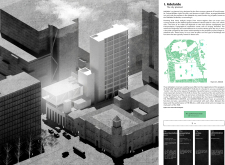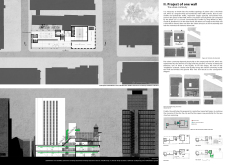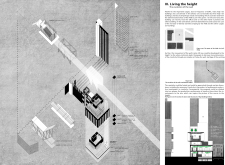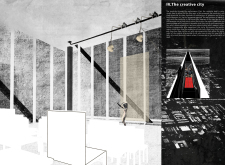5 key facts about this project
Functionally, the hub is designed to house various elements, including performance spaces, educational facilities, and areas for administrative functions. The architectural design emphasizes flexibility, allowing for a multifunctional environment conducive to a wide range of activities, from theater productions to educational workshops. Central to its layout is the performance zone, which is designed to be adaptable to different uses, encouraging a dynamic atmosphere that engages the public and showcases local talent. The educational spaces complement the overall mission by providing environments for learning and creativity, fostering skill development and community growth.
The architectural design meticulously integrates a series of key components that contribute to the project’s objectives. Pedestrian pathways guide visitors through the space, promoting easy navigation and fostering a sense of community. These pathways are strategically placed to connect distinct areas of the hub, ensuring that each function remains accessible and welcoming. Additionally, common areas, such as cafes and lounges, invite informal gatherings, further enhancing social interaction among residents and visitors alike.
Materiality plays a significant role in setting the tone of the building. The project utilizes a palette of concrete, glass, steel, wood, and green roof systems. Concrete serves as a robust structural element, ensuring durability and longevity. The extensive use of glass in the facades invites natural light into the spaces, creating an inviting atmosphere and reducing energy consumption, while steel is employed in structural elements that provide design flexibility. The use of wood brings warmth and character to the interiors, making the environment more inviting and comfortable. Lastly, the integration of green roof systems contributes to sustainability goals, supporting thermal regulation and promoting biodiversity.
One of the project’s notable design approaches is its focus on verticality. This aspect is not merely a stylistic choice but a strategic decision that maximizes space efficiency within the urban context. By layering various functions and creating vertical connections, the design reflects a modern interpretation of urban living without overwhelming the landscape. Furthermore, the concept of a “living wall” enriches the project’s ecological footprint, integrating nature with architecture and encouraging a dialogue between the built and natural environments. This unique approach fosters an atmosphere where the community can appreciate both artistry and the benefits of ecological stewardship.
In summary, the Creative Community Hub in Adelaide stands as a testament to thoughtful architectural design. Its multifaceted approach ensures that it caters to the diverse needs of the community while enhancing the urban fabric. This project exemplifies how architecture can serve as a catalyst for cultural connectivity and social well-being. To explore further details regarding architectural plans, architectural sections, and architectural ideas that illustrate this project more comprehensively, we invite you to delve deeper into the presentation of this innovative hub.


























